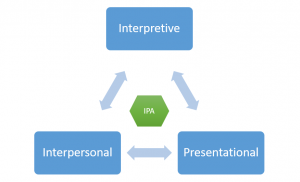Designing Integrated Performance Assessments
- FLAD
- Foreign Language Assessment Directory
- Understanding Assessment Tutorial
- Introduction
- Validity
- What do I want to know?
- What skills do I want to measure?
- What is the intended purpose of the test?
- How will I use the test results?
- What information will the test provide?
- Show what you know!
- Puzzle Piece
- Reliability
- What is the relationship between reliability and validity?
- How do I determine if a test is reliable for my situation?
- What could affect reliability?
- Show what you know!
- Puzzle Piece
- Practicality
- Do I have the resources to use this test in my classroom?
- What are the practical considerations for test administration?
- What are the practical considerations in scoring a test?
- Show what you know!
- Puzzle Piece
- Impact
- What are the possible effects of a test?
- What does positive washback look like?
- What does negative washback looks like?
- Who will be affected?
- How will different stakeholders be affected?
- Show what you know!
- Puzzle Piece
- Putting It All Together
- Needs Assessment
- Resources
- Heritage Language Assessment Module
- Introduction
- Linguistic Characteristics and Considerations
- Cultural Characteristics and Considerations
- Factors in Language Development
- Program Types
- Implications for Assessment
- Show What You Know!
- Assessing HLLs: The Why
- Assessing HLLs: The What
- Placement Tests
- Formative Assessment
- Summative Assessment
- Examples of Effective Assessment Tasks
- Summary of Best Practices
- Show What You Know!
- Assessing HLLs: The How
- Needs Assessment
- Selecting Assessments
- Modifying Assessments
- Developing Assessments
- Show What You Know!
- Putting It All Together
- Resources
- Introduction
- Post-Secondary World Language Assessment Module
- Introduction
- Proficiency
- Acquiring Proficiency
- Proficiency Levels
- Proficiency-Based Approach to Assessment: The What
- Proficiency-Based Approach to Assessment: The Why
- Proficiency-Based Approach to Assessment: The How
- Types of Assessments
- Summary of Best Practices
- Show What You Know!
- Placement Testing
- Placement Testing: The Why
- Placement Testing: The How
- Types of Assessment Tools and Approaches for Placement
- Selecting Placement Tests
- Additional Considerations
- Using Placement Test Results
- Summary of Best Practices
- Show What You Know!
- Assessment Plans
- Assessment Plans: The Why
- Assessment Plans: The How
- Aligning Assessment with Instruction
- Performance-based Assessment Tasks
- Designing Performance-based Assessment Tasks
- Scoring Performance-based Assessment Tasks
- Using Integrated Performance Assessments
- Designing Integrated Performance Assessments
- Intercultural Communicative Competence
- Assessing Intercultural Communication
- Assessing Cultures
- Assessment and Program Articulation
- Summary of Best Practices
- Show What You Know!
- Putting It All Together
- Resources
How do I design an Integrated Performance Assessment?

IPAs have a typical structure, with interpretive tasks first, followed by interpersonal and presentational tasks which may be in either order. Remember that each task informs the subsequent task. You can create an IPA using the following steps:
Think about the learning outcomes and proficiency targets of your unit or course and what tasks would be authentic and appropriate for your students.
Select an authentic text to be read, listened to, or watched by your students and design your interpretive task and overall context for the IPA.
Design your interpersonal and presentational tasks. Check that each task builds upon previous tasks.
Develop or modify the rubrics that you will use to evaluate student performances.
- Plan how and when you will provide feedback during and after the assessment. Make sure to dedicate time for each IPA task that includes review of the rubric and performance expectations, performance, and feedback.
To prepare your students for success on IPAs, you can share the introduction that provides context and purpose for the series of tasks well in advance, model task expectations and share exemplars of student performance, and provide regular opportunities for practice that may include self- and peer-assessment.
To learn more about creating an IPA unit and view example IPAs, see the CARLA Virtual Assessment Center series Create an Assessment Unit Step-by-Step.
